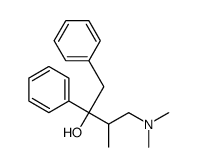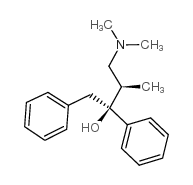126-04-5
| 英文名 | α-[2-(dimethylamino)-1-methylethyl]-α-phenylphenethyl alcohol |
|---|---|
| 英文别名 |
4-Dimethylamino-3-methyl-1,2-diphenyl-butan-2-ol
EINECS 204-765-3 4-dimethylamino-3-methyl-1,2-diphenylbutanol |
| 密度 | 1.043g/cm3 |
|---|---|
| 沸点 | 418.7ºC at 760mmHg |
| 分子式 | C19H25NO |
| 分子量 | 283.40800 |
| 闪点 | 160.2ºC |
| 精确质量 | 283.19400 |
| PSA | 23.47000 |
| LogP | 3.31460 |
| 蒸汽压 | 2.36E-07mmHg at 25°C |
| 折射率 | 1.565 |
| 分子结构 | 1、 摩尔折射率:88.24 2、 摩尔体积(cm3/mol):271.4 3、 等张比容(90.2K):686.6 4、 表面张力(dyne/cm):40.9 5、 极化率(10-24cm3):34.98 |
| 计算化学 | 1.疏水参数计算参考值(XlogP):3.7 2.氢键供体数量:1 3.氢键受体数量:2 4.可旋转化学键数量:6 5.互变异构体数量:无 6.拓扑分子极性表面积23.5 7.重原子数量:21 8.表面电荷:0 9.复杂度:279 10.同位素原子数量:0 11.确定原子立构中心数量:0 12.不确定原子立构中心数量:3 13.确定化学键立构中心数量:0 14.不确定化学键立构中心数量:0 15.共价键单元数量:1 |
Synonym:None Known Section 2 - COMPOSITION, INFORMATION ON INGREDIENTS
Risk Phrases: None Listed. Section 3 - HAZARDS IDENTIFICATION EMERGENCY OVERVIEW
The toxicological properties of this material have not been fully investigated. Potential Health Effects Eye: May cause eye irritation. Skin: May cause skin irritation. Ingestion: May cause irritation of the digestive tract. The toxicological properties of this substance have not been fully investigated. Inhalation: May cause respiratory tract irritation. The toxicological properties of this substance have not been fully investigated. Chronic: No information found. Section 4 - FIRST AID MEASURES Eyes: Flush eyes with plenty of water for at least 15 minutes, occasionally lifting the upper and lower eyelids. Get medical aid. Skin: Get medical aid. Flush skin with plenty of water for at least 15 minutes while removing contaminated clothing and shoes. Wash clothing before reuse. Ingestion: Never give anything by mouth to an unconscious person. Get medical aid. Do NOT induce vomiting. If conscious and alert, rinse mouth and drink 2-4 cupfuls of milk or water. Wash mouth out with water. Inhalation: Remove from exposure and move to fresh air immediately. If not breathing, give artificial respiration. If breathing is difficult, give oxygen. Get medical aid. Notes to Physician: Section 5 - FIRE FIGHTING MEASURES General Information: As in any fire, wear a self-contained breathing apparatus in pressure-demand, MSHA/NIOSH (approved or equivalent), and full protective gear. Dusts at sufficient concentrations can form explosive mixtures with air. During a fire, irritating and highly toxic gases may be generated by thermal decomposition or combustion. Will burn if involved in a fire. Runoff from fire control or dilution water may cause pollution. Extinguishing Media: Use foam, dry chemical, or carbon dioxide. Use agent most appropriate to extinguish fire. Section 6 - ACCIDENTAL RELEASE MEASURES General Information: Use proper personal protective equipment as indicated in Section 8. Spills/Leaks: Vacuum or sweep up material and place into a suitable disposal container. Clean up spills immediately, observing precautions in the Protective Equipment section. Avoid generating dusty conditions. Provide ventilation. Section 7 - HANDLING and STORAGE Handling: Wash thoroughly after handling. Remove contaminated clothing and wash before reuse. Use with adequate ventilation. Minimize dust generation and accumulation. Avoid breathing dust, vapor, mist, or gas. Avoid contact with eyes, skin, and clothing. Keep container tightly closed. Avoid ingestion and inhalation. Storage: Keep container closed when not in use. Store in a cool, dry, well-ventilated area away from incompatible substances. Section 8 - EXPOSURE CONTROLS, PERSONAL PROTECTION Engineering Controls: Facilities storing or utilizing this material should be equipped with an eyewash facility and a safety shower. Use process enclosure, local exhaust ventilation, or other engineering controls to control airborne levels. Exposure Limits CAS# 126-04-5: Personal Protective Equipment Eyes: Wear appropriate protective eyeglasses or chemical safety goggles as described by OSHA's eye and face protection regulations in 29 CFR 1910.133 or European Standard EN166. Skin: Wear appropriate protective gloves to prevent skin exposure. Clothing: Wear appropriate protective clothing to minimize contact with skin. Respirators: Follow the OSHA respirator regulations found in 29 CFR 1910.134 or European Standard EN 149. Use a NIOSH/MSHA or European Standard EN 149 approved respirator if exposure limits are exceeded or if irritation or other symptoms are experienced. Section 9 - PHYSICAL AND CHEMICAL PROPERTIES Physical State: Powder Color: white - off-white Odor: Not available. pH: Not available. Vapor Pressure: Not available. Viscosity: Not available. Boiling Point: Not available. Freezing/Melting Point: 55 - 57 deg C Autoignition Temperature: Not available. Flash Point: > 110 deg C (> 230.00 deg F) Explosion Limits, lower: Not available. Explosion Limits, upper: Not available. Decomposition Temperature: Solubility in water: insoluble Specific Gravity/Density: Molecular Formula: C19H25NO Molecular Weight: 283.40 Section 10 - STABILITY AND REACTIVITY Chemical Stability: Stable under normal temperatures and pressures. Conditions to Avoid: Incompatible materials, dust generation, excess heat, strong oxidants. Incompatibilities with Other Materials: Oxidizing agents. Hazardous Decomposition Products: Carbon monoxide, oxides of nitrogen, irritating and toxic fumes and gases, carbon dioxide. Hazardous Polymerization: Will not occur. Section 11 - TOXICOLOGICAL INFORMATION RTECS#: CAS# 126-04-5 unlisted. LD50/LC50: Not available. Carcinogenicity: (2S,3R)-(+)-4-Dimethylamino-1,2-Diphenyl-3 -Methyl-2-Butanol - Not listed by ACGIH, IARC, or NTP. Section 12 - ECOLOGICAL INFORMATION Section 13 - DISPOSAL CONSIDERATIONS Dispose of in a manner consistent with federal, state, and local regulations. Section 14 - TRANSPORT INFORMATION IATA Shipping Name: Not regulated. Hazard Class: UN Number: Packing Group: IMO Shipping Name: Not regulated. Hazard Class: UN Number: Packing Group: RID/ADR Shipping Name: Not regulated. Hazard Class: UN Number: Packing group: Section 15 - REGULATORY INFORMATION European/International Regulations European Labeling in Accordance with EC Directives Hazard Symbols: Not available. Risk Phrases: Safety Phrases: S 24/25 Avoid contact with skin and eyes. WGK (Water Danger/Protection) CAS# 126-04-5: No information available. Canada CAS# 126-04-5 is listed on Canada's NDSL List. CAS# 126-04-5 is not listed on Canada's Ingredient Disclosure List. US FEDERAL TSCA CAS# 126-04-5 is listed on the TSCA inventory. SECTION 16 - ADDITIONAL INFORMATION N/A |
|
~% 
126-04-5 
126-04-5 |
| 文献:Pohland; Sullivan Journal of the American Chemical Society, 1953 , vol. 75, p. 4458,4460 Full Text Show Details Stoll et al. Helvetica Chimica Acta, 1950 , vol. 33, p. 1194,1207 Helvetica Chimica Acta, 1950 , vol. 33, p. 1208,1216 |
| 上游产品 2 | |
|---|---|
| 下游产品 1 | |



